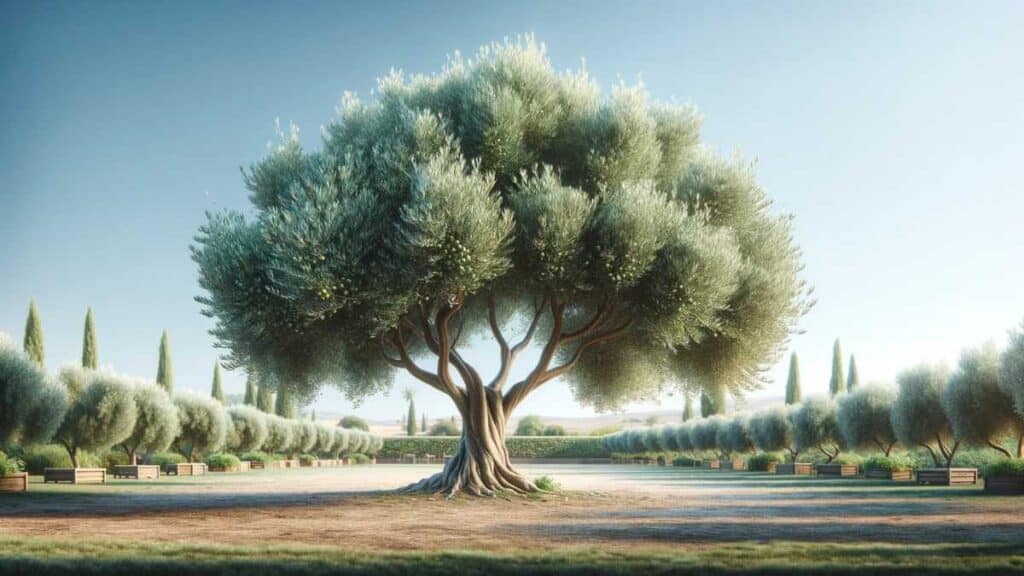How To Shape an Olive Tree? A Beginner’s Guide
Olive Knowledge is a part of Amazon Associates. As an Amazon Associate, we earn from qualifying purchases. Read our Affiliate Disclosure to learn more.
Olive trees can be farmed in a variety of styles and shapes. Since there are thousands of different olive tree cultivars in the world, they unavoidably come in a range of sizes, from tiny kinds that barely reach two to four feet in height to those that may reach heights and widths of more than forty feet.
Use this guide as an aid to learn how to shape an olive tree the way you desire.
Shapes of Olive Trees

Although olive trees can be found in many different shapes throughout the Mediterranean region, in this article, we’ll talk about the most common and fundamental one.
Mono-conical Shape
If we speak in less mathematical terms, the shape is that of a Christmas tree. The Christmas tree is a new concept with no historical precedent in the Mediterranean region. It was created using shakers that were first created in California for mechanical picking.
Recent scientific studies carried out in Italy have revealed that the Christmas tree shape isn’t much better for mechanical picking than the vase. Also, the Christmas tree is more difficult to manage.
Poly-conical Shape
The shape refers to a vase or wine glass. Vases come in a variety of shapes and are by far the most widely used and useful for hand or semi-mechanical picking in the Mediterranean region. A wine glass is a perfect shape for an olive tree, with the main trunk giving way to three or four primary branches.
The vase features a higher surface-to-volume ratio, less empty space in the center, and a canopy that is distributed more evenly. This shape is recommended for farmers who have a few trees or a tiny grove.
Strategies for Shaping Olive Trees
Formative pruning is required to shape an olive tree so that it becomes fuller, bushy, wider, or even taller.
Learn two distinct pruning methods below and how to apply them to upkeep the shape of your olive tree in accordance with your objectives.
1. Central-leader Standard Olive Tree

This method is for you if you want an olive tree with a distinct core branch that leads all other branches upward and gets higher, bushier, and wider as it grows. This method is ideal if you don’t care too much about commercial cultivation and want your olive tree to seem wild and natural in your backyard setup.
The most important thing is to avoid cutting this central leader branch because doing so can ruin the intended shape of your olive tree. Wait until your olive tree is around 1.5m tall before selecting three or four strong, strategically placed shoots to make up the primary structure. This will help a young tree establish a good shape.
You don’t need to prune your olive tree the first year because olive trees purchased from garden centers have some training already.
In the second year, trim the lower side shoots of the olive tree completely, the middle side shoots by half, and the top section of the olive tree of any crossing or misplaced branches. For the third year, take the same steps.
During the fourth and fifth years, clear the olive trunk of side shoots and branches to the desired height. To mold the desired shape, keep removing branches that are crossing, misplaced, dead, or diseased.
2. Open-centered Olive Tree

If you want to manage your olive tree’s size, make it bushier and wider, and produce more olives, use this vase form strategy. Commercial olive tree producers can benefit greatly from using this formative pruning technique to increase production.
You can adhere to the identical procedures as the central-leader standard olive tree for the first three years.
Cutting to an upper, strong side shoot, trim back the leading olive branch in the fourth year. To create the olive tree’s branches, leave 2 or 4 side shoots in the upper portion uncut. Remove any poorly positioned branches, crossing, or rubbing. Cut the middle side shoots of the olive tree in half to save stubs that can serve as replacement branches if necessary. Remove all the lower olive tree’s side shoots, keep the main trunk free of obstacles, and keep it clean.
Remove any significantly upward-growing branches for the fifth year that could dominate the canopy and ruin the desired shape. Remove any branches that are touching or crossing one another. To balance the shape of your olive tree, lightly prune the canopy branches and side sprouts. For open growth, cut to an upward-facing bud.
When the Olive Tree Is in Its Perfect Shape
According to folklore, olive trees should be pruned until they are cut so that a bird may fly through them.
It’s not very realistic to estimate the total foliage density while hiding in an olive grove and watching the birds.
According to science, you should prune until you have a leaf area index of three or four. The ratio of the area of the tree’s leaves to the area of ground they cover is known as the leaf area index. Even more, time would be required to count the leaves than would be required to observe the bird’s flying patterns.
I’d suggest keeping an eye on the other trees in your area and being aware of the signs of under-pruning. Under-pruning is typically a beginning mistake because it is quite unlikely that you will have the courage to over-prune.
Frequently Asked Questions About How to Shape an Olive Tree
Try to transfer your indoor olive tree outside during the spring and summer so it may be exposed to airflow. Due to the air circulation, the olive tree trains and grows a much thicker, more robust trunk.
The end of winter or early spring, before the new growth, is the ideal time to shape an olive tree.
For the first year, treat the olive tree with a slow-release nitrogen fertilizer once a month from spring to summer. Avoid fertilizing in winter.
